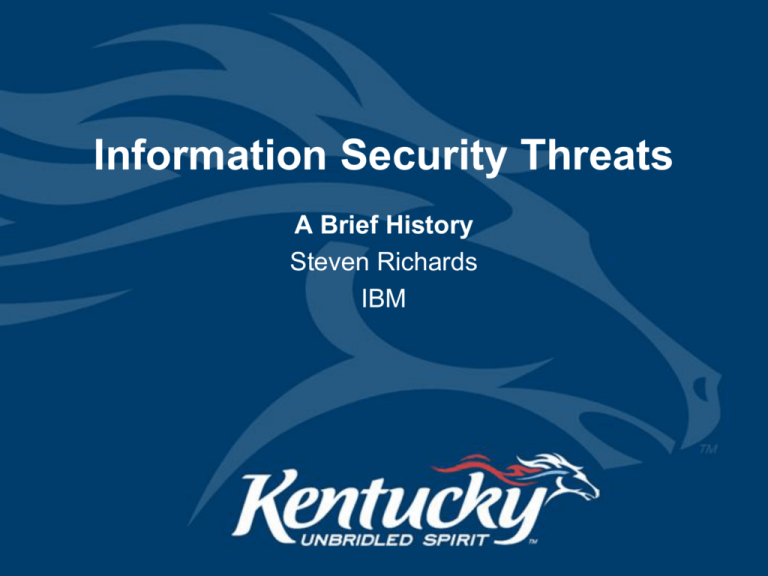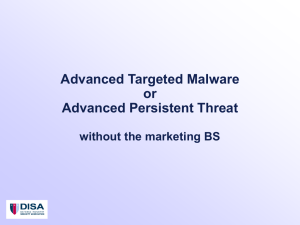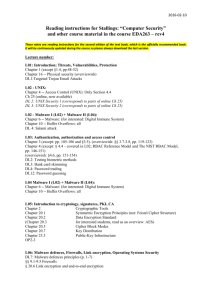Tempo Program
advertisement

Information Security Threats A Brief History Steven Richards IBM “The three golden rules to ensure computer security are: do not own a computer; do not power it on; and do not use it.” Hacker fun…. “What’s my computer saying to me?” Here’s what he saw on his screen… • Shift from “Glory-Motivated-Vandals” to “Financially-Politically-Motivated-Cyber- Crime” – They are more organized and collaborative – They have a Roadmap – They are playing Chess • The “Designer Worms” and “Designer Trojans” – What are the implications when Patient ZERO *is* the only target? – http://www.uscert.gov/cas/techalerts/TA05-189A.html • The Bot-Networks (Worms Bots) – – – – – “Computational Currency” SPAM Relays Spyware/Adware subscriptions Distributed Denial of Service Attacks ID Harvesting ©2005 Commonwealth Office of Technology 10 ©2005 Commonwealth Office of Technology 11 1.5M credit & bank cards And ~$4M damages ©2005 Commonwealth Office of Technology 12 ©2005 Commonwealth Office of Technology 13 “China has downloaded 10 to 20 terabytes of data from the NIPRNet (DOD’s Non-Classified IP Router Network),” said Maj. Gen. William Lord, director of information, services and integration in the Air Force’s Office of Warfighting Integration and Chief Information Officer, during the recent Air Force IT Conference in Montgomery, Ala. “They’re looking for your identity so they can get into the network as you,” said Lord, adding that Chinese hackers had yet to penetrate DOD’s secret, classified network. “There is a nation-state threat by the Chinese.” LT. COL. JOE RUFFINI, COUNTERTERRORISM EXPERT: Yes, we did, Glenn. There have been several instances of computer disks recovered, the ones you`re talking about in Iraq, some Department of Education schools, emergency crisis management plans were found on the disk, school floor plans, school emergency response plans. But the point I`d like to make here is, you know, when we post this stuff on our Web sites, we can`t get surprised when our enemies download it. ©2005 Commonwealth Office of Technology 14 Best Practices are Still Best Practices • Network • Systems • Applications • Data • Users ©2005 Commonwealth Office of Technology 15 ©2005 Commonwealth Office of Technology 16 Securing the Web Gateway Charles King Blue Coat Systems Secure Web Gateway 1.0 • • • URL Filtering database w/daily updates – Objectionable & Unproductive Content – Employee monitoring placed demands on Auth options Limited Web Anti-Virus deployments – Performance/Scale Issues – Lack of Web Threats vs Expense Emerging IM & P2P controls – • Productivity was the main issue to solve Evaluation interest, very little adoption Bandwidth Management – Younger employee downloads (music, video, etc.) An Enterprise Without Boundaries Managed Datacenter Outsourced Web Apps Branch Office Branch Office •LOB Users are Everywhere App File Servers • Applications are Everywhere • Performance is Poor E-Mail Intranet • Security is Poor Branch Office Internet Economic Drivers • Legal Economy – Online Ads, Online Ads, Online Ads • – Information Access, 24/7, Anywhere • • Driven by Search Engines & Collaborative Content Performance is expected, latency means “closed” Illegal Economy – Identities are the new currency • – Personal, CRM/HR databases, Laptops Malware infrastructure • Segmented functions (detect, develop, rent, execute) • Goal to be undetected/invisible Then IT Gets Worse – Web 2.0 • Web 2.0 makes the web an application platform collaborative two-way content and mash-ups – • New Services & Shapes – • Blogs, Wikis, Podcasts, RIAs, RSS, Tagging, Widgets New Technologies – • SaaS, Social Computing, Collective Intelligence Applications/Techniques – • Architecture of participation and remixable data sources AJAX, Flash/Flex, XML, XAML, OpenAPIs, Plugins Today’s Toys, Tomorrow’s Tools… – YouTube for training, Wikis for collective intelligence – Provides strong ROI for companies with Attack Vector Shift • • Attacks shift to HTTP/SSL over SMTP – 83% of SPAM contains a URL – Injected html/iframes in popular websites (malframes) • 70% of web-based infections in legitimate websites • Undetected by firewalls, static URL filtering, reputation scores and AV scanning for known threats/signatures • Fast-flux services constantly change DNS records every few minutes, or 1000s of sub-domains hide the real site making hostIDs useless to mitigate threats Follow the herd, leads to “browse-by” infections – Olympics, Sporting Events, Elections, Major News May’07 Google Report Web 2.0 – Security Perspective • Pervasive Accessibility – • Open Environment – • Everyone can publish/contribute Rich Experience – • Blends work & social environments Complex activities behind interface Web 2.0 Creates: – More avenues for data leakage – More surface areas for attacks – Greater transparency for attackers – Complicated trust scenarios – Erosion of traditional boundaries Traditional security castle walls erode Your Web 2.0 Security Profile Exposure Points • • • Public website: – Host for injection pointer (MMC) to a malware server – Malware payload server – Mask for phishing attacks Private network: – Botnet infection for outbound attacks (SPAM, DoS, etc.) – Source of identity information (CRM, HR, Credit Cards, etc.) – Exposed to other networks (partners, services) Remote clients: – Web access via networks you do not control – Undefended except for laptop security tools (AV, PFW) – Laptops often stolen for identity lists (consultants, auditors, etc.) – Rarely limit web content access (URL filtering) Your Web 2.0 Business Profile • Application Agility: – Leverage SaaS to outsource services/applications • – Leverage web-based applications across WAN • • • Sales Mgmt, Travel, Benefits ERP, SCM, HR, Payroll, Expenses Increase Collaboration and Productivity: – Provide collaborative knowledge tools to employees and business partners – Online eLearning with voice, video & streaming media – Provide LAN-like office experience “everywhere” Manage Risk: – Web security controls need to remove threats and latency at all locations (Data Center, Branch Office, Remote User) – Slow Security = No Security New Role for URL Filtering • Malware source blocking – – Collect 24/7 high volume user requests into threat labs • Web 2.0 technologies block web spiders that crawl web for content • User driven methodology replaces web crawlers Simulate desktop to unwrap attacks (honey clients) • – Multi-threat engine analysis & deep content inspection • – – • Custom encryption wrappers cloak attacks past gateways New proactive detection techniques (genes, skeletons) Human rater review to avoid over blocking & false positives • Attack pointers in popular websites do not need blocking • Block malware sources, not the widespread deployed pointers Immediate update to URL database Real-time rating service to reduce “unrated” sites – Common policy to allow unrated sites, reduces help desk calls – Translation sites, Image Searches, Cached Content, etc. Threat Detection Role Changes • • IF malware is not blocked by URL categorization AND download payload has custom encryption – THEN desktop threat prevention engine provides defense – ELSE (no custom crypto wrapper) then SWG threat prevention engine provides first defense, then desktop second defense User authenticated web content (MySpace, Facebook) and P2P downloads (encrypted) – • Proactive detection techniques (genes, skeletons) take lead over signature databases – • Desktop threat prevention engine provides defense Q1’08 shows large increase in threat variants (10X – KL/RSA) WW Security Software market is $7.4B for 2007 (Gartner) – 54.3% is AV vendors, resulting in ~$4B funding for anti-malware solutions SPAM Reputation Ratings • Most SPAM includes a URL today leading to malware source download sites (Valentine’s Day, April Fool’s Day – STORM) • Reputation ratings on malware hosts quickly eliminates SPAM at email gateways, attackers respond with fast-flux DNS profiles – • • Email/SPAM host databases started in 2003/2004 era Web-based attacks leverage pointers in popular websites to malware sources, surge in 2H2007 due to success rate – April’08/iFrame - USA Today, Target, Wal-Mart (SANS) – HTTP/S is now top threat vector over SMTP BIG QUESTION – What is the overlap between email SPAM and Web malware hosts? IronPort/Cisco Secure Computing Proofpoint email/SPAM Malware Hosts Web Malware Hosts Blue Coat Websense Web Application Firewalls • Emerging niche to manage 100s of web applications – Update dynamic port stateful inspection firewalls as HTTP/S are dominant services/ports for web traffic • NIDS architecture with web application signatures at Layer-4 for performance, inspects HTTP/S traffic • Selected instances marketing as seen with P2P, IM and other emerging web technologies • QUESTION – Do you want to manage a policy for 100s of web application controls? • – Most customers dug into P2P and IM with interest, then backed away with simple web gateway policies in the end – Gateway (& desktop) URL filtering with threat detection engines block a high percentage of web threats – Web 2.0 fear vs enablement for productivity gains Likely to become a new feature in web gateways going forward if revenues are minimal – Repeat of IM & P2P gateway solutions? SWG Request Controls - Outbound • Outbound Requests: – URL filtering + real-time rating service • – Plus IWF, custom lists, allow/deny lists, etc. Data Loss Prevention (DLP) integration via ICAP • Vontu, VeriCept, Reconnex, Port Authority, etc. – User & Group Authentication & Authorization policies – Policy controls by user, location, service, destination, time, content – Method level controls per protocol (ex. restrict outbound files) – Certificate validation checks (e.g. SSL) Internet URL Filtering DLP Checks AAA Policy Method Controls Cert. Validation SWG SWG Request Controls - Inbound • Inbound Requests: – Threat analysis (MMC & Malware), proactive & signature checks • Kaspersky and Sophos are showing leading test results – Protocol Compliance (buffer overflows, e.g. Quicktime - iTunes) – Content Filters (attachments, executables, file types, etc.) – Apparent data typing & container mismatch detection – Active content validation checks Malware Detection Protocol Content Compliance Filters Data Types Active Content Internet URL Filtering DLP Checks AAA Policy Method Controls Cert. Validation SWG SWG Request Controls - All • All Requests: – Default & Custom Logging & Reporting – Object Caching upwards of 50% (optional for SSL) • Object Pipelining & Adaptive Refresh technologies – Bandwidth Management (e.g. Streaming media) – Protocol Optimization Object Cache Bandwidth Management Protocol Optimization Log Files Reporter Malware Detection Protocol Content Compliance Filters Data Types Active Content Internet URL Filtering DLP Checks AAA Policy Method Controls Cert. Validation SWG Web Applications A Change in the Times Kristen Sullivan System/Data Vulnerabilities Web applications are the #1 focus of hackers: 75% of attacks at Application layer (Gartner) XSS and SQL Injection are #1 and #2 reported vulnerabilities (Mitre) Most sites are vulnerable: 90% of sites are vulnerable to application attacks (Watchfire) 78% percent of easily exploitable vulnerabilities affected Web applications (Symantec) 80% of organizations will experience an application security incident by 2010 (Gartner) System/Data Vulnerabilities Common myths and false senses of security: "We have a firewall" "We use Network vulnerability Scanners" The Reality: Security and Spending are Unbalanced (according to Watchfire and Gartner) 75% of attacks are to the application, but only 10% of money allocated for security goes to protecting applications 25% of attacks are to the network 90% of the money allocated for security goes to protection of the network SQL Injection • SQL Injection is a method of attacking a system to gain access or control over the database layer of an application. It is also categorized as the ability of user to influence SQL statements. Other Examples of Injection • • • • • Javascript Injection LDAP Injection HTML Injection PHP Injection Email Injection Cross-Site Scripting The User is the Victim Cross-Site Request Forgery (CSRF) Using the User as an Accomplice Feel like this now? Feeling Like This Now??? Finding a Balance It’s obviously unrealistic to assume that every vulnerability can be fixed. Some Solutions INPUT VALIDATION • Input Validation is the validation or sanitization of input data to ensure that it is safe and is not malicious. • If an unexpected input occurs, abort! • Input Validation is IMPERATIVE! • Validate all data received from the user’s browser – Hidden form fields, check boxes, select boxes all require validation! Just because the user cannot edit the values doesn’t mean they can’t be changed. Whitelisting vs. Blacklisting • • • • What is a Blacklist? What is a Whitelist? Which is better and why? If you are a non –believer, see http://ha.ckers.org/xss.html Train, Train, Train • SSL Certificates and Man-In-The-Middle attacks • Surfing the web can be dangerous HIPPA, IRS 1075, etc. • Compliance is not just in the business rules • Vulnerabilities within applications can cause an agency to fall out of compliance Assess Regularly and Often “Instead of brushing security on, we have to bake it in.” Resources • • • • • • • www.gartner.com www.mitre.org www.watchfire.com www.symantec.com www.fbi.gov www.f-secure.com www.nctimes.com • www.theage.com.au • www.wired.com



